











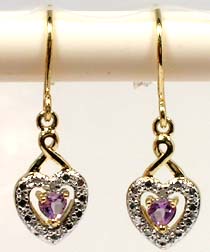
NEW 18kt Gold Electroplated Silver Diamond-Accented Amethyst Semi-Precious Gemstone French Hooks.
GEMSTONE SIZE: Two 3mm amethyst hearts. Two 1mm diamond rounds. All measurements approximate.
EARRING SIZE: Height: 17 millimeters. Breadth: 7 millimeters. Total Drop: 26mm. All measurements approximate.
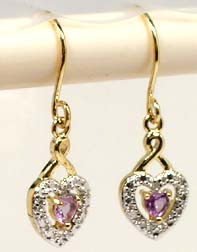
DETAIL: Shamans of the ancient and medieval world used amethyst to assist prophecy and visions. Amethyst was also used in spells designed to magnify beauty. In Renaissance magic, an amethyst engraved with the image of a bear was worn as a protective amulet, and had the power to put demons to flight. Most ancient Mediterranean cultures, including the ancient Romans, Greeks, Persians and Celts believed that amethyst protect soldiers from harm in battle. In both ancient Greece and Rome rings of amethyst set in bronze were worn as charms against evil. The first century historian and naturalist Pliny wrote that if amethyst were worn round the neck on a cord made from dog's hair, it would afford the wearer protection against snakebite. Ancient accounts relate that (third century Roman) Saint Valentine owned a ring set with an antique amethyst carved with an image of Cupid.
Celebrating mankind's cultural and historical legacy here are two lovely amethyst gemstones in nice quality 18kt gold over sterling silver french hook earrings, accented with ONE diamond on each side. Though the earrings are cleverly and very convincingly manufactured to each appear to contain twenty 1mm accent diamonds, we want to emphasize that there is in reality only one 1mm diamond accent on each side (a total of two). However except to very close examination, each of the earring pair appears to contain twenty diamond accents, and the appearance is quite convincing. You have to examine the earrings very intently to realize that with the exception of the centermost, top accent (which is a genuine diamond), all of the other “diamond” accents are in fact merely metal made to look like a prong-set diamond accent. It is only the centermost, top accent on each earring that are actually diamonds. In any event, the earrings (which are new) are very handsome and appealing, and do contain two genuine 1mm diamond accents, and two genuine amethysts as well.
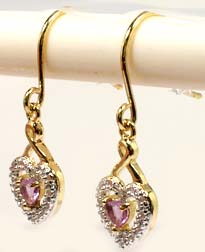
AMETHYST HISTORY: Amethyst was one of the first gemstones used by man. Archaeologists have uncovered amethyst gemstones in burials dating back to the late Neolithic (5,000 B.C.). An amethyst bracelet was recovered at Abydos, in the tomb of the Pharaoh Djer, dating back to 3,000 B.C. Other notable finds in Egyptian archaeology have included an amethyst and gold “heart scarab”, from the tomb of Amenemhet II (20th century B.C.), an amethyst and gold anklet from the tomb of Queen Mereret in the funerary complex of Senusret III (19th century B.C.), and of course an amethyst bead bracelet from the tomb of Tutankhamun (14th century B.C.). In ancient Egypt, soldiers as well used to wear amethyst to remain calm during battle. The ancient Persians believed amethyst could ward off witchcraft when the stone was carved with a sun symbol.
The name “amethyst” is derived from the Greek term "amethustos", meaning not drunk. Most ancient Mediterranean cultures believed that amethyst would protect against becoming intoxicated, and would protect soldiers from harm in battle. It was also believed that if a person drank from a cup or goblet made entirely of amethyst, he or she would not get drunk at all. Amethyst was also extensively used since ancient times for carving intaglio gemstones and seals, particularly by the ancient Greeks and Romans. In both ancient Greece and Rome rings of amethyst set in bronze were worn as charms against evil. Amethyst came to Greece from Egypt just after the death of Alexander the Great.
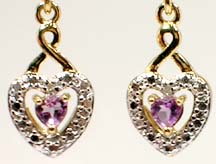
In Greek mythology, amethyst was rock crystal dyed purple by the tears of Dionysus, the god of wine and revelry (“Bacchus” to the ancient Romans), and the stone was believed to protect female wearers from seduction. Throughout ancient and medieval history, the color purple was traditionally the color of royalty, and was also associated with the planet and the Roman God Jupiter the “Lord of Gods” of the Roman pantheon, also known as Zeus to the ancient Greeks). Consequentially Amethyst has been used since the dawn of recorded history to adorn the wealthy, as well as royalty. Ancient civilizations prized the stone more than many other gems which today enjoy more recognition and value, including sapphire, ruby, diamonds and emerald.
For some time in the ancient world, amethyst was valued equally with the diamond, and only royal families were lawfully entitled to own and wear the stone. In ancient Rome, the first century historian and naturalist Pliny wrote that if amethyst were worn round the neck on a cord made from dog's hair, it would afford the wearer protection against snakebite. Later the fourth century Roman Catholic Priest Hieronymus (also known as Saint Jerome) even reported that eagles placed an amethyst in their nest in order to protect their young from the danger of snakebite. Amethyst was widely used in the Roman world both in jewelry, and as mentioned earlier, as carved intaglios for use in signet rings.
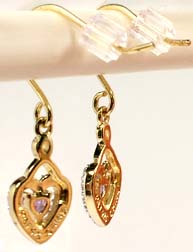
Another ancient Roman account relates that (third century Roman) Saint Valentine owned a ring set with an antique amethyst carved with an image of Cupid. The stone was also a symbol of Saint Matthias (the apostle chosen by the remaining eleven apostles to replace Judas Iscariot following Judas' betrayal of Jesus and his suicide). Amethyst is also mentioned in the Bible (Exodus 28:19; 39:12) as one of the 12 stones adorning the breastplate (hoshen) of the high priests of Yahweh. Also described in the Bible, the twelfth foundation of the mythical (post rapture) heavenly “Holy City” is said to be built of amethyst. Moses described it as a symbol of the Spirit of God in the official robes of the High Priest of the Jews.
For many centuries Amethyst was worn by ancient priests and priestesses as a personal magical stone and focus of power. In a modern continuation of this tradition the Pope wears an amethyst ring, which absorbs so much of his personal energy that it must be buried with him or destroyed when he dies. In the early medieval church amethyst stood for piety and celibacy and was therefore worn by members of the Catholic Church clergy and was used to adorn crosses. It was particularly used in Bishops’ rings, the royal purple color symbolizing Christ and the bishop’s Episcopal authority. First mentioned as an official part of the bishop's insignia in the early seventh century, the ring, usually made of gold with an amethyst, came to symbolize a bishop's fidelity to and nuptial bond with the church, his spouse.
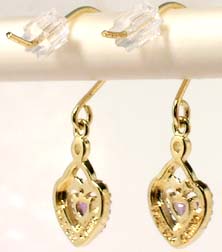
Today, bishops frequently wear an oval shaped amethyst, usually very large, with the diocesan seal engraved directly into the flat surface of the gem. Very good quality amethyst gemstones were also found in Aztec graves, though the deposits from which they were extracted are no longer known today. Aside from it use in medieval ecclesiastical jewelry, Amethyst also remained extremely popular in the jewelry of royalty. The oldest known stone in the Crown Jewels of England is an amethyst first worn in the 11th century by Edward the Confessor. In the Medieval world, Amethyst was also attributed with the power to control evil thoughts, and make its owner shrewd in business matters. It was also employed as a love charm, as a potent influence in improving sleep, as protection against thieves, to help the hunter in search of his game, and to protect the wearer from contagious diseases and insect bites.
In the Medieval world amethyst was also worn as a talisman to protect crops against tempests and locusts. Medieval European soldiers wore amethyst amulets as protection in battle. In Renaissance magic, an amethyst engraved with the image of a bear was worn as a protective amulet, and had the power to put demons to flight. Amethyst was believed to bring forth the highest, purest aspirations of human kind. Chastity/celibacy, sobriety, and control over one’s thoughts were all attributes heightened by wearing the stone. The gem would guard against the anger of passion, and the violent or base nature of its wearer. The stone was believed to encourage calm, bravery, and contemplation. Shamans of the ancient and medieval world used amethyst to assist prophecy and visions. Amethyst was also used in spells designed to magnify beauty.
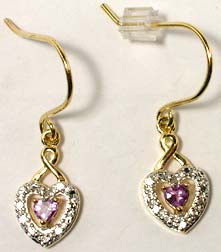
Amethyst is the most highly valued variety of quartz. The purple coloring is caused by the presence of compounds of iron or manganese. Aside from the gorgeous color, Amethyst is also very popular in the production of jewelry due to the fact it is very hard and durable. Huge 18th century finds in South America and Russia (the Russian Empress Catherine the Great sent thousands of miners into the Siberian Urals to look for it) made it more plentiful, and as its rarity decreased, so did its price. For many experts in the trade, the amethyst from the Ural Mountains in Siberia are considered the finest amethyst ever produced.
Some of the other popular varieties of quartz include rock crystal (colorless quartz), citrine (yellow quartz), and aventurine (green quartz). Amethyst, like all quartz crystals, produces an electric voltage, a property known as piezoelectric. Unable to understand the characteristic, ancient cultures attributed many mystical properties have been attributed to the various varieties of quartz gemstones. Quartz gemstones were believed to act as psychic purifiers, tuning one into their inner "vibrations”. It was believed that quartz possessed the ability to amplify emotions, enhance concentration and intuition, and neutralize "negative energies".

Throughout history, gemstones were believed capable of curing illness to providing protection. Found in Egypt dated 1500 B. C., the "Papyrus Ebers" offered one of most complete therapeutic manuscripts containing prescriptions using gemstones and minerals. In the eastern civilizations of China, India, and Tibet, gemstones were not only valued for their medicinal and protective properties, but also for educational and spiritual enhancement. The medicinal uses of amethyst were many, including as a treatment for excess stomach acidity. A few centuries ago it was the practice to moisten the stone with saliva and rub it on the face to banish pimples, rough skin, and skin rashes.
In traditional Chinese medicine, amethyst was prescribed for stomach pains and bad dreams, and was also be used for the healing of illnesses of the lungs as well as heart disease. It was believed to help detoxify the body, strengthen the immune system, and was used to treat ailments involving the central nervous system as well as the brain. Not only would amethyst alleviate a headache, cure deafness and relieve arthritis, but it would also help clear one’s thinking process, allowing one to process information more efficiently. The metaphysical benefits of wearing amethyst included the ability to enhance and focus psychic abilities (opening the “third eye”, enabling visions of past lives and the inner self), as well as to calm nightmares and relieve insomnia.

Wearing amethyst was believed to make the wearer gentle and amiable, and was also used to treat manic-depressives by bringing thought patterns into alignment, soothing overactive minds. It was believed to exert a calming influence on individuals prone to compulsive behavior, as well as (in the ancient world) over professional warriors who were addicted to the adrenaline rush of combat and warfare. When placed under a pillow, it was believed that an amethyst would induce pleasant dreams and self healing, and was believed to help with conscious recall of dreams and symbolic message.
Amethyst was also believed to attract wealth and power to the wearer. In the Chinese philosophy of Feng Shui, amethyst enhances the wealth corner focusing on the giving and receiving of material wealth. Amethyst was also regarded as a stone of love, exchanged between lovers as a token of mutual commitment. Amethyst was believed to loosen blocks in the mind where mental functioning had become confused and undirected, and to free the way to clearer thinking. Amethyst was also believed to help people who suffered from a faulty memory.

In addition amethyst was used to help those prone to depression and melancholy. Amethyst was also often used to relieve stress and heal stress-related illness. It was considered to be especially effective for headaches, muscle tension and back or neck ache. Many also believed that amethysts were useful for those working to transcend chemical dependence, the stone working as a talisman to provide inner strength when battling dependency. Amethyst was also one of the few gemstones specifically prescribed for men to use to attract a “good woman” to love him.
DIAMOND HISTORY: In the ancient world there was only one source of diamonds…India. Bombay remains today one of the world’s great diamond cutting centers (along with New York, Tel Aviv, and Antwerp). Over 800,000 cutters are employed in the city of Bombay alone; cutting 90% of the world’s diamonds. The best Indian diamonds originated from the Majhgawan pipe, near Panna, India, which was discovered in 1827. However India is no longer a big producer of mined diamonds, producing only about 20,000 carats a year.

Australia produces 2,000 times more diamonds each year – about 40 million carats a year; followed by 20 million carats a year for the Congolese Republic, 15 million carats a year for Botswana, and 10 million carats a year each for Russia and South Africa. However this region of India did produce some of the world’s greatest diamonds, including the Great Mogul (793 carats), the Regent (410 carats), the Nizam (340 carats), the Orloff (194 carats), the Kohinoor (132 carats), and the Hope or Blue Tavernier (112 carats).
The traditional Indian supplies of diamonds which had fed the appetites of the ancient world for thousands of years were almost exhausted when enormous new alluvial deposits of diamonds were discovered in 1725 in Brazil, followed by the staggering discoveries of 1870 in South Africa. Perhaps the earliest symbolic use of diamonds was as the eyes of Hindu devotional statues. The diamonds themselves were thought to be endowments from the gods and were therefore cherished. The point at which diamonds assumed their divine status is not known, but early texts indicate they were recognized in India since at least 400 B.C.

The word most generally used for diamond in Sanskrit was vajra, or "thunderbolt," and the possession of diamond was according to ancient Hindu texts thought to bring, “happiness, prosperity, children, riches, grain, cows and meat. (As well) he who wears a diamond will see dangers recede from him whether he (is) threatened by serpents, fire, poison, sickness, thieves, flood or evil spirits." The ancient Greeks believed diamonds were tears of the gods; and it is from the Greek word adamas, "untameable" or "unconquerable", referring to its hardness, that the word “diamond” is derived. The ancient Romans believed that diamonds were splinters of fallen stars.
The presence of diamond in Rome is established by the writings of Pliny the Elder (23-79 A.D.). Unfortunately according to Pliny, “these stones are tested upon the anvil, and will resist the blow to such an extent as to make the iron rebound and the very anvil split asunder." One can only imagine the numbers of genuine diamonds smashed into splinters by this ill-advised test. However even diamond splinters were valued by the Romans who used diamond points set into iron scribes to engrave sapphires, cameos, and intaglios. Even early Chinese references to diamond cite its coming from Rome in iron scribes. Chinese interest in diamond was strictly as an engraving or carving tool, primarily for jade, or as a drill for beads and pearls.

In western culture, diamonds have been the traditional emblem of fearlessness and virtue. Though most of the world’s diamonds are cut in Bombay, over 90% of the world’s rough diamonds are traded in Antwerp, Belgium. Between the 13th and 15th centuries the world’s diamond center had been Bruges; then Antwerp until the city’s capture by the Spanish in 1585 A.D.; then Amsterdam through the early 19th century, then back to Antwerp. The Portuguese colony of Goa was the point of origin for diamonds from India, the trade route developing from Goa to Lisbon to Antwerp and thus cutting out the traditional Arabic middle men.
Small numbers of diamonds begin appearing in European regalia and jewelry in the 13th century, set as accent points among pearls in splendidly wrought gold. Louis IX of France (1214-70 A.D.) decreed that diamonds were to be reserved for royalty alone, an indication of the rarity of diamonds and the value conferred on them at that time. The history of diamond cutting can be traced to the late Middle Ages, before which time diamonds were enjoyed in their natural octahedral state. At the time, diamond was valued chiefly for its brilliant lustre and superlative hardness. The most common (“table”) cut diamond would appear black to the eye, as they do in paintings of the era.

Diamond cutting is believed to have originated in Venice about 1330 A.D. By 1375 A.D. there was a guild of diamond polishers in Nurnberg. About a hundred years later absolute symmetry in the disposition of faceting was introduced and the most common cuts were known as pendeloque or briolette. About the middle of the 16th century, the rose cut was introduced. The first “brilliant cut” was introduced in the middle of the 17th century. By the 16th century as diamonds became larger and more prominent, their popularity had spread from royalty to the noble classes. This was in part a response to the development of diamond faceting, which enhanced their brilliance and fire. By the 17th century diamonds were becoming popular with the wealthy merchant class.
Diamonds occur in a variety of colors - steel, white, blue, yellow, orange, red, green, pink, brown and black. The most common diamonds, and arguably the most sought after (though not the rarest) are pure and colorless. The most common impurity is nitrogen, which if dispersed will give the stone a yellowish tint (but if clustered does not affect the diamond’s color). Diamonds without nitrogen impurities are often colored pink, red, or brown – the color arising from molecular structural anomalies. Blue diamonds are colored by boron impurities. A form of carbon, diamonds are not “forever”, even the Romans demonstrated that they will burn (or decay with heat).
However a diamond is likely the oldest thing you will ever own, probably 3 billion years in age, fully two thirds the age of the Earth. Diamonds are carbon crystals that form deep within the Earth under high temperatures and extreme pressures. For instance when as part of “plate teutonics” an ocean floor slides beneath the earth’s crust and into the mantle, entrapped organic carbon may eventually become diamond. They are created at depths generally more than 150 kilometers down into the mantle. Diamonds are brought back to the surface in a rare form of molten rock (or magma), that originates at great depths, which rises and erupts in small but violent volcanoes. When cooled, just beneath such volcanoes is a carrot-shaped "pipe" filled with volcanic rock, mantle fragments, and embedded diamonds.
Diamonds also form as a result of the immense pressures created by meteor impacts. Meteorites also experience impacts themselves and can contain diamonds. And the most ancient meteorite material contains star dust, the remnants of the death of stars. Some of this star dust are very small diamonds and are older than the solar system itself. New studies indicate that they formed more than 5 billion years ago in flashes of radiation from dying red-giant stars into surrounding clouds of methane-rich gas. If you would like to learn more about diamonds, please click here to visit a great web site by the American Museum of Natural History.
Domestic shipping (insured first class mail) is included in the price shown. Domestic shipping also includes USPS Delivery Confirmation (you might be able to update the status of your shipment on-line at the USPS Web Site). Canadian shipments are an extra $14.99 for Insured Air Mail; International shipments are an extra $18.99 for Air Mail (and generally are NOT tracked; trackable shipments are EXTRA). ADDITIONAL PURCHASES do receive a VERY LARGE discount, typically about $5 per item so as to reward you for the economies of combined shipping/insurance costs. Your purchase will ordinarily be shipped within 48 hours of payment. We package as well as anyone in the business, with lots of protective padding and containers.
We do NOT recommend uninsured shipments, and expressly disclaim any responsibility for the loss of an uninsured shipment. Unfortunately the contents of parcels are easily “lost” or misdelivered by postal employees – even in the USA. If you intend to pay via PayPal, please be aware that PayPal Protection Policies REQUIRE insured, trackable shipments, which is INCLUDED in our price. International tracking is at additional cost. We do offer U.S. Postal Service Priority Mail, Registered Mail, and Express Mail for both international and domestic shipments, as well United Parcel Service (UPS) and Federal Express (Fed-Ex). Please ask for a rate quotation. We will accept whatever payment method you are most comfortable with. If upon receipt of the item you are disappointed for any reason whatever, I offer a no questions asked return policy. Send it back, I will give you a complete refund of the purchase price (less our original shipping costs).
We travel to Russia each year seeking antique gemstones and jewelry from one of the globe’s most prolific gemstone producing and cutting centers, the area between Chelyabinsk and Yekaterinburg, Russia. From all corners of Siberia, as well as from India, Ceylon, Burma and Siam, gemstones have for centuries gone to Yekaterinburg where they have been cut and incorporated into the fabulous jewelry for which the Czars and the royal families of Europe were famous for. My wife grew up and received a university education in the Southern Urals of Russia, just a few hours away from the mountains of Siberia, where alexandrite, diamond, emerald, sapphire, chrysoberyl, topaz, demantoid garnet, and many other rare and precious gemstones are produced. Though perhaps difficult to find in the USA, antique gemstones are commonly unmounted from old, broken settings – the gold reused – the gemstones recut and reset.
Before these gorgeous antique gemstones are recut, we try to acquire the best of them in their original, antique, hand-finished state – most of them centuries old. We believe that the work created by these long-gone master artisans is worth protecting and preserving rather than destroying this heritage of antique gemstones by recutting the original work out of existence. That by preserving their work, in a sense, we are preserving their lives and the legacy they left for modern times. Far better to appreciate their craft than to destroy it with modern cutting. Not everyone agrees – fully 95% or more of the antique gemstones which come into these marketplaces are recut, and the heritage of the past lost. But if you agree with us that the past is worth protecting, and that past lives and the produce of those lives still matters today, consider buying an antique, hand cut, natural gemstone rather than one of the mass-produced machine cut (often synthetic or “lab produced”) gemstones which dominate the market today.
Our interest in the fabulous history of Russian gemstones and the fabulous jewelry of the Czar’s led to further education and contacts in India, Ceylon, and Siam, other ancient centers of gemstone production and finishing. We have a number of “helpers” (family members, friends, and colleagues) in Russia and in India who act as eyes and ears for us year-round, and in reciprocity we donate a portion of our revenues to support educational institutions in Russia and India. Occasionally while in Russia, India, Siam, and Ceylon we will also find such good buys on unique contemporary gemstones and jewelry that we will purchase a few pieces to offer to our customers here in America. These are always offered clearly labeled as contemporary, and not antiques – just to avoid confusion. We can set most any antique gemstone you purchase from us in your choice of styles and metals ranging from rings to pendants to earrings and bracelets; in sterling silver, 14kt solid gold, and 14kt gold fill. When you purchase from us, you can count on quick shipping and careful, secure packaging. We would be happy to provide you with a certificate/guarantee of authenticity for any item you purchase from me. There is a $2 fee for mailing under separate cover. Please see our "ADDITIONAL TERMS OF SALE."


| |||||||||||||||||||||













